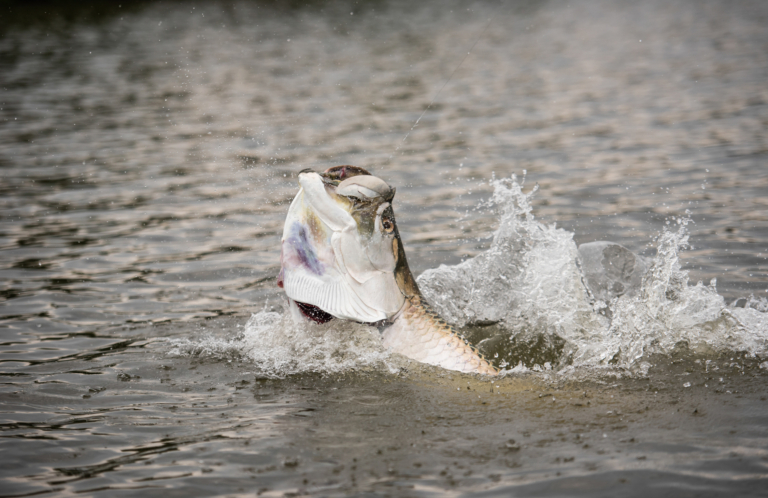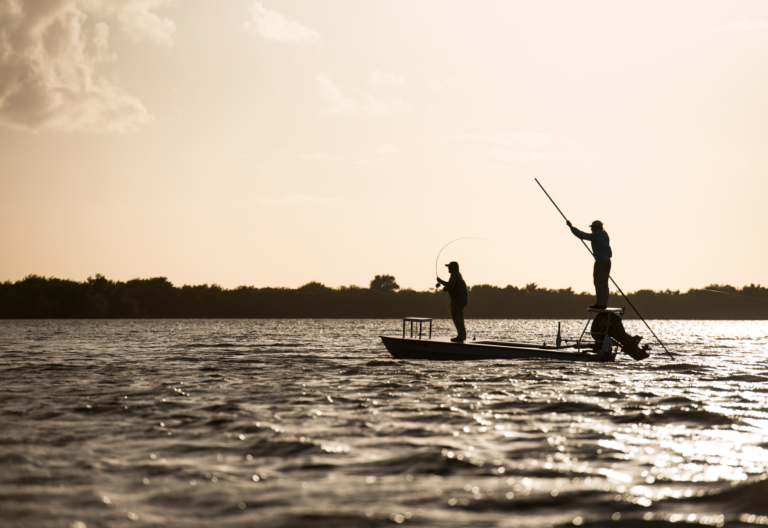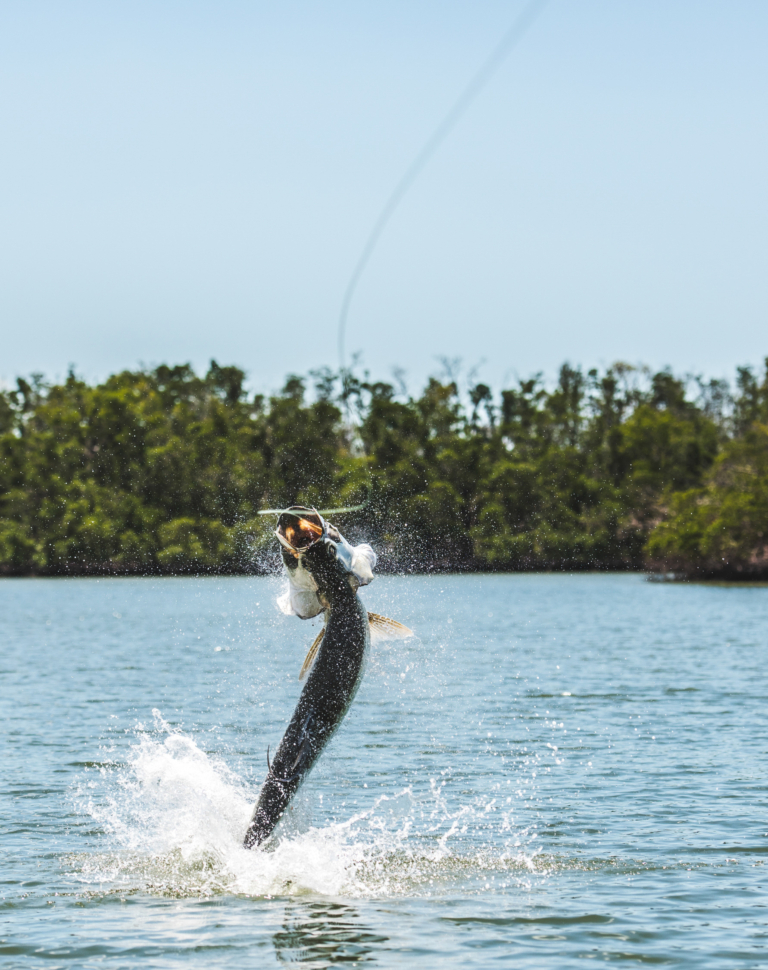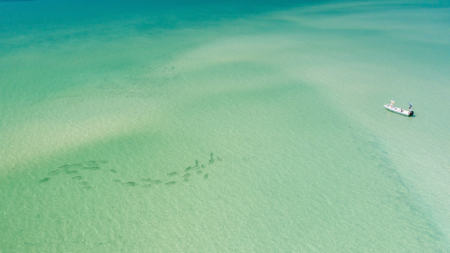It’s All Home Water: The Crash of Florida’s Tarpon Capitol
A Small Florida Town Was Once Host to the World’s Largest Tarpon. What Happened?
The tarpon is one of the most magnificent animals on the planet. I say this subjectively, of course. I am an angler. But consider: They have been on earth for 50 million years (we inhabit their world and not the other way around). They can live to the age of 80. They grow to enormous sizes (six-to-seven feet in length and more than 300 pounds) and are stunning to behold, sleek and silver-scaled with lightly brushed-in hues of purple and green on their backs. They are so stunning, in fact, that on the ceiling of the Sistine Chapel, Michelangelo decided to paint a tarpon, and not a whale, about to devour the prophet, Jonah.
And every year, around the spring moons, these denizens of the ocean’s great deep water—which remains eighty percent unexplored—visit the shallow water flats, primarily in the Caribbean and Gulf of Mexico, where we, if we’re lucky, can connect with them.
Homosassa, a small coastal town some 70 miles north of Tampa, Florida, was once the tarpon-fishing equivalent of El Capitan in the climbing world or of Yankee Stadium in baseball. In the late 1970s, a group of anglers discovered some of the world’s largest tarpon—thousands upon thousands of them—swimming the white sand flats of Homosassa Bay. And for a period of five or so years, a remarkable thing happened: the world’s best fly anglers—legends like Stu Apte, Ted Williams, Billy Pate, Flip Pallot and Tom Evans—gathered together each spring, all with the goal of catching the world record tarpon on a fly rod. The record fell every year as Homosassa became the fishing world’s apex moment. The New York Times, Sports Illustrated and ABC Sports all covered the chase. There was even a movie made about it, produced by the conglomerate, 3M.
But, a few years later, the fish disappeared. The fishing world’s Edenic playground fell and has never been redeemed, for reasons—and with consequences—that resonate far further than just the world of angling.

Tarpon on the business end of a fly rod are unrelenting. Aerials, runs, bulldogging, direction changes and, in an attempt to spit the hook, never-ending head shakes. Photo: Oliver Rogers
Scientists believe that the enormous tarpon that come to Homosassa every spring are a specific subgroup of the greater tarpon population. They likely returned to the area, en masse, because that’s what their forbearers did for eons—until something happened that changed their habits, or at least the habits of the majority of them. Starting in the late 1980s, the annual run of tarpon in Homosassa—those thousands and thousands of fish—decreased by some 90 percent.
The increased angling pressure on Homosassa that resulted from the publicity of the record chase may have played a small role in the destruction of the fishery. Tarpon, in general, do not like boats. But they do tolerate them. The tarpon in the Keys are subjected to a significant number of boats and anglers all year long. And while they are much harder to fool with a fly these days than they were decades ago when they were less pressured, they continue to show up there in robust numbers.
The tarpon in Homosassa, on the other hand, do not.
Homosassa is located on what’s known as Florida’s Springs Coast, named so for its four major spring-fed rivers—the Homosassa, Chassahowitzka, Weeki Wachee and Crystal—and the hundreds of other smaller springs that all empty into Homosassa Bay. The area was once among the state’s sleepiest. The painter, Winslow Homer, used to travel there in the winter precisely for its peace and tranquility.
But that tranquility was shattered with the sounds of construction that began in the late 1970s when developers began building two master-planned communities—the Villages of Citrus Hills and Sugarmill Woods. Today, these developments have seven thousand homes and six golf courses combined. They are both located on big, spring-fed rivers that empty into Homosassa Bay.
These two communities were on the vanguard of a major change for the area. Citrus County (where Homosassa is located) and Hernando County (which borders much of Homosassa Bay south of Citrus County) were, for a few decades following the 1970s, two of the fastest-growing counties in the United States. In 1970, Citrus County had 19,000 inhabitants. By 1990, it had 93,500, and now it has 163,000. Hernando County had 17,000 residents in 1970. By 1990, that number had risen to 101,000 and now stands at 194,000.
Retirees fueled most of the growth, and dozens of planned communities were built to accommodate them. Golf courses were built to entertain them. The two counties had only a handful of courses in the late 1960s. By 2000, Hernando County had nineteen courses, three times as many, per capita, than the national average. Citrus and Hernando now have close to 35 courses combined.
The one thing all of those new developments and golf courses have in common is the need for significant amounts of fresh water. That freshwater comes from a portion of the upper Floridan aquifer, which lies beneath Citrus and Hernando Counties and feeds the area’s rivers and springs. By the early 2000s, Hernando County alone was using fifty million gallons of water a day. Homesites, agriculture, and some residual mining pumped out a lot of that water. So did the golf courses, which used something like 370,000 gallons per course every day of the year. (In 2001, six Hernando County golf courses were caught pumping more than their prescribed limit.) That water usage, coupled with severe droughts in Florida in 1980 and 1984, served to draw down the aquifer and reduce the flow of local springs. Adding insult to that injury, much of the groundwater became polluted with pesticides and other lawn-maintenance chemicals, as well as nitrates from fertilizer, cow dung, and leaky septic tanks. Nitrate levels in the region’s four main rivers increased by a factor of five between the 1960s and 1990s. Eighty-five percent of the Homosassa River pollution is caused by humans (from fertilizer, livestock waste, etc.). In the Chassahowitzka River, humans account for 81 percent of the pollution. (Forest fires and biological decay are two types of nonhuman pollution, just FYI.)
Historically, the area’s rivers and springs pumped around a billion gallons of fresh water into the Homosassa Bay every day. But since 1980, there has been a drastic decline in the amount of freshwater entering the bay. The flow in the Crystal River has been reduced by 58 percent. The flow of the Chassahowitzka River has been reduced by 55 percent. The Florida Springs Institute, a science-based nonprofit, recently released a report that assigned grades for Florida’s major spring-fed rivers, based on their flow. The Homosassa-area rivers did not fare well. The Crystal, Chassahowitzka, and Homosassa Rivers all received Fs. The Weeki Wachee River, star student of the bunch, got a D. Less freshwater means more salinity in the bay and in the springs, a problem that’s been exacerbated by rising sea levels in recent years.
This lack of freshwater has had consequences.

When a tarpon is “laid-up” it’s not actively hunting food or cruising, it’s chilling. Sneaking up on these hyper-wary fish is tough work for a guide/angler team. Steve Huff works to pole angler Kyle Giampaoli into position for a shot at a laid up silver king. Photo: Oliver Rogers
In the 1960s, commercial crabbing was the biggest industry in Homosassa. Blue crabs were everywhere—mating in rivers and floating the ocean currents in Homosassa Bay, plentiful to the point of absurdity. The crabs attached themselves to the trim tabs on the backs of flats skiffs. They tried to grab hold of the fishing guides’ push poles, their pincers futilely clacking against the graphite.
The tarpon that came to Homosassa feasted on those crabs. “Every day, you’d see the crabs swimming all over the surface of the water and the tarpon busting on them,” says Ronnie Richards, a longtime local guide. It was the sheer abundance of the nutrient- and oil-rich crabs that likely attracted those Homosassa tarpon to the area in the first place and also helped them attain their stupendous sizes. And it may be that the sudden disappearance of those blue crabs drove the tarpon away.
The blue crabs of Homosassa Bay, as it turns out, needed freshwater, too. They mate in freshwater and, because the spring-fed rivers that empty into Homosassa Bay are not rich in organic nutrients, they relied on the plentiful brackish areas—which are rich in nutrients—to feed. The abundance or scarcity of blue crabs is “directly tied to freshwater flow,” says Ryan Gandy, a research scientist for Florida Fish and Wildlife. According to a study done by the University of North Carolina Wilmington, the higher salinity levels that result from reduced freshwater flow are associated with lower survival rates, slower molting, and higher predation mortality for blue crabs. As the freshwater flow into Homosassa Bay dissipated, so did the number of blue crabs. By 2000, Gandy says, the biomass of blue crabs in the area had dropped to half of what it was in the 1970s. Thus, the Homosassa tarpon no longer had quite the impressive buffet spread they’d become accustomed to. And it is likely no coincidence that when the blue crabs no longer appeared in great numbers, neither did the tarpon. The equation is rather simple: less freshwater equals fewer crabs and, thus, fewer tarpon.
Alas, the state of Florida, that beautiful, fucked-up wonder world, seems to always do its best—at least when it comes to the work of some of its state officials—to remain beautifully fucked up…
The exhaustion of aquifers is a problem for more than just tarpon anglers, of course. Without proper management, entire ecosystems—and the state’s water supply—are in peril (80 to 90 percent of the freshwater used in Florida is groundwater). The Southwest Florida Water Management District (SWFMD) is the state agency responsible for monitoring the health of the area’s aquifers and water supply. And it is their official position that a lack of rainfall, and not groundwater pumping, is the leading cause of the Springs Coast’s aquifer’s depletion. “Rainfall in that area was a lot higher in the sixties and seventies,” says Kym Rouse Holzwart, a senior environmental scientist for the SWFMD. “Then it went down.”
Scientific and environmental groups disagree with this assessment. “That’s a lie. It’s a political answer,” says Robert Knight, an environmental scientist who runs the Florida Springs Institute. “The SWFMD toes this line because if they told people that they couldn’t take any more groundwater, every developer in the state would get a new legislature elected. The government and the water management districts are just doing the bidding of the developers.”
I suppose people will believe whichever side of this argument they want to believe, as is the standard operating procedure these days. But there are facts involved here, and let’s let them get in the way, shall we? Yes, rainfall is the way the aquifer is replenished. But the SWFMD’s claim that there has been much less rain since the 1960s and 1970s? The data on the SWFMD’s own website reflect that the 1980s were pretty wet. The 1990s were a bit drier, and that the first two decades of the new millennium have been mixed when it comes to rainfall, with one decade being dry and another being wet. In other words, the data demonstrate fluctuations in annual rainfall by decades. These fluctuations in rainfall have been the norm and not the exception, forever.
So, the claim that there has been some drastic difference in rainfall by the decades is overstated, at the very least. But this is beside the point, and focusing on rainfall is a misdirection, and perhaps a deliberate one. What matters here is that, historically, through all of those drought years and all of those wet years—all of those fluctuations—the springs always maintained their sustained, normal flow, according to Todd Kincaid, a geohydrologist who has extensively studied the Homosassa area’s springs. The difference between now and 1910, or now and even 1960? The springs no longer sustain their normal flow, even in non-drought years. And that’s because of one thing: groundwater withdrawal. “People just want to believe in magic, that you can just take as much water as you like for as long as you like from the aquifer and have no deleterious effect,” says Kincaid. “That’s just ludicrous.”
Indeed, government agencies in Florida do not have a stellar track record when it comes to protecting and conserving the state’s water, specifically, and its environment, in general. Former Florida governor Jeb Bush did once try to help the springs, signing a springs restoration initiative into law. But four years after he left office, Rick Scott, a governor notorious for his pro-development and anti-environment stances, undid the law. In fact, Scott’s SWFMD board was so egregiously anti-environment and so obviously in the pocket of one of the state’s biggest polluters (the sugar industry) that every single member was forced to resign after Scott left office in 2019. “We do the science, and we publish reports,” says Knight. “And then the government changes laws to reflect that. But the SWFMD doesn’t enforce existing laws. The pumping is the problem, and they’re still issuing permits every day.”
The problem isn’t really a technical one. It’s a political one.
It’s also a solvable one, which makes it all the more frustrating. It’s hard for us, as individuals, to truly believe that we have any control over some of our bigger environmental challenges, like global warming, which is almost so large a problem that it’s ungraspable. It is more within our purview to exert some control and influence over smaller things that happen more locally, like the polluting of estuaries and aquifers’ depletion. But when that available control is left unexecuted, it makes these minor tragedies—which, linked together, create the big, ungraspable one—more frustrating and, well, sadder. They are more tangible, and they are preventable, and when they occur, the loss is felt more deeply.
What’s happened in Homosassa serves as a microcosm for what’s happened all over Florida, inland and on the coasts, from the nitrate-based toxic algae in Lake Okeechobee that is periodically and disastrously flushed out to both coasts, to the freshwater-starved Everglades and Florida Bay, which are dying right in front of our eyes. Ill-thought-out development, bought-and-paid-for politicians, the drying up of aquifers, the unsustainable development of coastal lands, the intentional misinformation, the worshipping of economic progress above all other types of progress…all of this has led to an ecological catastrophe that’s yet to be fully acknowledged.

Hooked by Harrison Rogers, a muscular tarpon reaches exit velocity off Florida’s east coast. Photo: Oliver Rogers
We are currently in a geological age that many scientists suggest naming the Anthropocene—that is, the geological age in which humans, and not ice ages or extreme heat or asteroids, are the significant influences on the earth and its environment. We are also in the midst of an enormous loss of biodiversity, a sixth extinction. A lot of that loss doesn’t happen dramaticlly: though species across the globe are going extinct at alarming rates, much of the damage is what’s known as defaunation, a decline in abundance. According to Aaron Adams, the lead scientist at the conservation group, Bonefish & Tarpon Trust (BTT), freshwater issues have already led to a decrease in tarpon populations, a decrease that will not cease—and, indeed, will only accelerate—unless they are dealt with as soon as possible.
Tarpon are a truly remarkable species that has adapted and adjusted to every adverse condition it has faced so far. But the biggest test for tarpon, and for all species on earth, for that matter (including humans!), may come from the Anthropocene. For if we continue on our current path, in our current ways, the next geological age may be what the biologist and naturalist E. O. Wilson has termed the Eremocene, the age of loneliness.
And the loss of the tarpon in Homosassa—that loneliness in what was once a spot of awe and abundance—might just a harbinger of worse things to come.
But it doesn’t have to be. We can—and must—act. The Bonefish & Tarpon Trust, based in Miami, does invaluable science, research and advocacy on behalf of tarpon (and bonefish and permit) all over the world. They led the charge for designating tarpon as a catch-and-release species. They’ve identified, protected and restores juvenile tarpon habitat. They are the leading voice in the conservation of the species, and could use your help.
And while you’re at it, get involved with the small but mightily effective folks at BullSugar, who hold the feet of all politicians in Florida when it comes to water issues in the state. Help water advocates—and not sugar companies and developers—become the most powerful lobby in the state of Florida.
This story was adapted from Monte Burke’s 2020 book, Lords of the Fly: Madness, Obsession, and the Hunt for the World Record Tarpon. Buy the book from your local independent bookseller.

